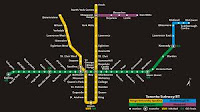Talk about a slow postal system.
More than two years ago, Cally Rumbolt's father put a note in a bottle and set it adrift off the shores of the Grand Banks of Newfoundland.
This year, Sofi-Ona Hamer fished it out of the North Atlantic Ocean near Scotland.
She didn't even know that he was doing it - until she received a couple of replies. Her latest is from Sofi-Ona, who noticed a bottle washed up on the shore as she was walking along a rocky beach in Scotland one rainy day recently.
She thought it was garbage and was going to put it in the recycling, when she realized there was a plastic bag inside it - and a note.
The note was faded and most of it was unreadable. She tried rubbing charcoal over the letters to see if she could get the note to become more readable. Finally, she was able to make out the words, "Pickering, Ontario, Canada" and the street, "Poprad Avenue" at the top of the page. She got in touch with The Toronto Star newspaper, and they helped her track down Cally's address.
Sofi-Ona couldn't read the note, but thanks to The Star, we know that this is what Cally's dad wrote in those letters he tossed over the side of the boat:
"My dad works on a supply vessel off the Grand Banks of Newfoundland... He is sending this note in a bottle in the hopes that someone will return a letter to me."
In addition to connecting with Sofi-Ona (who plans to write Cally now that she has her address), Cally received a letter from a 16-year-old girl in Ireland, who found a bottle while walking her dogs.
Writing/Discussion Prompt
If you wrote a message in a bottle what would it say? What types of things would you want to be certain to mention?
Curriculum Prompt
What types of things did you think about after you read the title of the article? As you read the article, did you need to change your understanding of what the article was about? After reading the article, would you say your first guess about the story was right or not so much? How can making guesses about what we read make us better readers?
Primary
Identify, initially with some support and direction, what strategies they found most helpful before, during, and after reading and how they can use these and other strategies to improve as readers (OME, Reading: 4.1).
Junior
Identify the strategies they found most helpful before, during, and after reading and explain, in conversation with the teacher and/or peers or in a reader’s notebook, how they can use these and other strategies to improve as readers (OME, Reading: 4.1).
Grammar Feature: Italics
At times, journalists will change the formatting of their text in an article. For example, in today’s story, our journalist switched her font to italics when she reported the message found on the notes. The reason journalists do this is to distinguish certain words from others.
FYI, italics is used in the same way as underlining. For that reason, a piece of work may contain italics or underlining, but not both).











.jpg)


.jpg)










